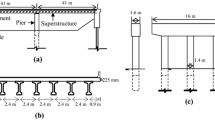Abstract
Integral bridges are a low-maintenance form of bridge construction used worldwide. Their jointless structure eliminates bearing and expansion joint replacement bringing a reduction in lifecycle cost, carbon emissions, and socio-economic impact from road and rail disruption, therefore offering a resilient infrastructure solution in the face of a changing climate. By better understanding earth pressure ratcheting in the backfill due to repeated thermal movements of the deck, integral bridge use can increase to greater spans and skews while excessive design conservatism can be reduced. This paper explores the integral bridge problem and design code prescriptions before using analytical, numerical, and centrifuge modeling to show that soil-structure interaction, especially the relative stiffness of soil and structure, can reduce abutment bending moments by 30% and that this is largely unaccounted for in the current U.K. design code PD 6694–1. Preliminary results showed a similar influence of stiffness on seismic response.
Access this chapter
Tax calculation will be finalised at checkout
Purchases are for personal use only
Similar content being viewed by others
References
Sakulich AR, Bentz DP (2012) Increasing the service life of bridge decks by incorporating phase-change materials to reduce freeze-thaw cycles. J Mater Civ Eng 24(8):1034–1042
Office of Rail and Road (2019) Annual assessment of Highways England’s performance
Hambly EC (1997) Integral bridges. Proc Instn Civ Engrs Transp 123, 30–38
Mitoulis SA (2020) Challenges and opportunities for the application of integral abutment bridges in earthquake-prone areas: a review. Soil Dynam Earthquake Eng 135
Choine MN, Oconnor AJ, Padgett JE (2015) Comparison between the seismic performance of integral and Jointed concrete bridges. J Earthquake Eng 19(1):172–191
British Standards Institute (2020) PD 6694–1:2011+A1:2020—Recommendations for the design of structures subject to traffic loading to BS EN 1997–1:2004+A1:2013. London
Wood DM (2004) Geotechnical modelling. Spon Press, Abingdon
Sandberg J, Magnino L, Nowak P, Wiechecki M, Thusyanthan I (2020) The integral bridge design concept for the third runway at Heathrow, UK. Proceed Inst Civil Eng Bridge Eng 173(2):112–120
Idaho Transportation Department (2008) Load resistance factor design (LRFD) bridge manua—chapter 11. Retrieved from https://itd.idaho.gov/bridge/
England GL, Tsang NCM, Bush DI (2000) Integral bridges—a fundamental approach to the time-temperature loading problem. Crown Copyright and Thomas Telford Limited, London
Denton S, Riches O, Christie T, Kidd A (2011) Developments in integral bridge design. Bridge Design to Eurocodes, UK Implementation
Tapper L, Lehane B (2004) Lateral stress development on integral bridge abutments. In: Australasian conference on the mechanics of structures and materials
Tan EL, Lehane BM (2007) Lateral stress development on integral bridge abutments. Perth
Springman SM, Norrish A, Ng CWW (1996) Cyclic loading of sand behind integral bridge abutments. Crowthorne
Bloodworth AG, Xu M, Banks JR, Clayton CRI (2012) Predicting the earth pressure on integral bridge abutments. J Bridge Eng 371–381
Ng C, Springman S, Norrish A (1998) Soil-structure interaction of spread-base integral bridge abutments. Soils Found 38(1):145–162
Chan AHC (1988) A unified finite element solution to static and dynamic problems of geotechnics. University College of Swansea
Schofield AN (1980) Cambridge geotechnical centrifuge operations. Geotechnique 30(3):227–268
Acknowledgements
This project was supported by National Highways, GDG Ltd. and the EPSRC CDT in Future Infrastructure and Built Environment (FIBE2 CDT).
Author information
Authors and Affiliations
Corresponding author
Editor information
Editors and Affiliations
Rights and permissions
Copyright information
© 2024 The Author(s), under exclusive license to Springer Nature Singapore Pte Ltd.
About this paper
Cite this paper
Morley, D.G., Asia, Y.B., Madabhushi, G.S.P., Thusyanthan, I., Sakufiwa, D. (2024). Influence of Relative Stiffness on Integral Bridge Design. In: Hazarika, H., Haigh, S.K., Chaudhary, B., Murai, M., Manandhar, S. (eds) Climate Change Adaptation from Geotechnical Perspectives. CREST 2023 2023. Lecture Notes in Civil Engineering, vol 447. Springer, Singapore. https://doi.org/10.1007/978-981-99-9215-7_6
Download citation
DOI: https://doi.org/10.1007/978-981-99-9215-7_6
Published:
Publisher Name: Springer, Singapore
Print ISBN: 978-981-99-9214-0
Online ISBN: 978-981-99-9215-7
eBook Packages: EngineeringEngineering (R0)




